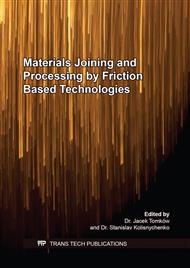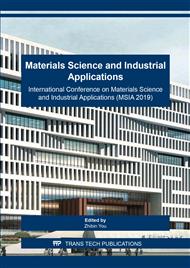p.3
p.9
p.15
p.21
p.26
p.32
p.39
p.47
Microstructures and Properties of Friction Stir Welded Al-Cu Lap Joints
Abstract:
Friction stir welded lap joints of 5083 aluminum alloy plates with thickness of 2mm and T2 pure copper plates with thickness of 3mm were prepared, and the microstructures and properties of lap joints were investigated. The results showed that Al and Cu interdiffusion occurred at the interface of the lap joints, the grains in the stir zone of Al were refined and the microhardness increased sharply. The joint of Cu can be divided into four parts, including the nugget zone (NZ), thermo-mechanically affected zone (TMAZ), heat affected zone (HAZ) and base metal (BM). Using the optimum welding parameters (rotation speed of 900rpm and welding speed of 100mm/min), the lap joints were well formed. There were fewer welding defects and the average shear tensile force reached 3.155KN. Also, the ductile-brittle hybrid fracture occurred at the transitional zone of the advancing side of the Al plates. XRD results showed that intermetallic compounds (IMCS) mainly composed of Al2Cu and AlCu4 were produced in the interface of the lap joints during welding.
Info:
Periodical:
Pages:
9-14
Citation:
Online since:
May 2019
Authors:
Price:
Сopyright:
© 2019 Trans Tech Publications Ltd. All Rights Reserved
Share:
Citation:



